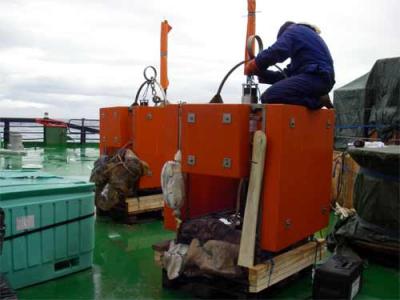Latitude: 59 S Longitude: 63.5 W Temperature: 9 degrees C
We have passed the Antarctic Convergence in our transit across the Drake Passage with a combination of gentle rolls and rocky waves! This boundary is not fixed, but fluctuates and marks the spot where warm water meets cold Antarctic waters. Our current location is approximately halfway across the Drake Passage. We are proceeding towards the Shetland Islands where the first project off of the ship will be done. The plan is to find a spot to overnight at as well as a weather system passes.
The science teams met today to discuss the 13 different science projects that will be done on this expedition! My next few journals will introduce you to the US and Swedish science teams and their work. Several on-going projects have already begun.
Dr. Kirsty Kemp and Adrian Glover from the Natural History Museum of London are working in collaboration with Thomas Dahlgren and Helena Wiklund from Gotenborg University. The project is focused on the chemo-synthetic environment where the energy source for life is not sunlight, but chemical processes. Three main types of these environments are hydrothermal vents, cold seeps on the ocean floor, and environments of biological origin (biogenic) such as whale carcasses. Why whales? Turns out whales bones have the high fat content that bacteria can use to generate energy. However this project is not as interested in the bacteria as it is on the symbiotic relationship it has with polychaete worms they live in. These worms in the genus Osedax ("bone-eating worms") look like little flowers. They root inside the bone where the bacteria are able to access the fat to produce the energy that the worms can use!
PICTURE COMING SOON
The main questions Dr. Kemp and her colleagues are investigating are: What species of this worm exist in the Southern Ocean; how are they related to other species in other oceans; and has industrial scale whaling in the past affected the communities that live on whale bones? Although these worms have been found in most oceans, studies have never been done in the Antarctic. So, Dr. Kemp has collected
whale bones from strandings and will attach them and some pieces of wood to two landers. The landers will deliver them to the ocean floor where they hope they will be colonized by bacteria and worms. They will remain there for a year, and then will be retrieved using an acoustic signal which tells the lander to drop its ballast, allowing it to rise with its own buoyancy.
**Preparing the bones **
 Kirsty drills through the bones to tie them.
Kirsty drills through the bones to tie them.
**Bones attached to lander **
 The lander is ready for the cast-the really large bone is part of a skull!
The lander is ready for the cast-the really large bone is part of a skull!
**Lander is cast **
 The lander begins its descent!
The lander begins its descent!
Another project already underway is a study of the Atlantic and Western Antarctic ocean. Dr. Henrik Kylin from the Swedish Agricultural University and Dr. Rebecca Dickhut from the Virginia Institute of Marine Science are looking at those areas to determine if they are sources or sinks of Persistent Organic Pollutants (POPs).Using air and water samples beginning in the North Atlantic to the Antarctic seas, they are collecting data to determine the presence in the air and water of POPs. POPs affect the health of the food chain in the oceans because they don't degrade, they are toxic, and they are harmful to the environment.
**Rebecca and Henrik at air collection system **
 Rebecca and Henrik check the air collection system on the deck.
Rebecca and Henrik check the air collection system on the deck.
**Rebecca collects water sample **
 Rebecca collects water sample from sea water system.
Rebecca collects water sample from sea water system.
Lollie

